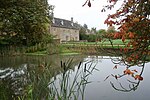Great Rissington
AC with 0 elementsCotswold DistrictGloucestershire geography stubsUse British English from March 2015Villages in Gloucestershire

Great Rissington is a village in the Cotswold district of Gloucestershire, England. The population taken at the 2011 census was 367.
Excerpt from the Wikipedia article Great Rissington (License: CC BY-SA 3.0, Authors, Images).Great Rissington
Sherborne Lane, Cotswold District Great Rissington
Geographical coordinates (GPS) Address Nearby Places Show on map
Geographical coordinates (GPS)
| Latitude | Longitude |
|---|---|
| N 51.855 ° | E -1.7186111111111 ° |
Address
St John the Baptist, Great Rissington
Sherborne Lane
GL54 2LW Cotswold District, Great Rissington
England, United Kingdom
Open on Google Maps









